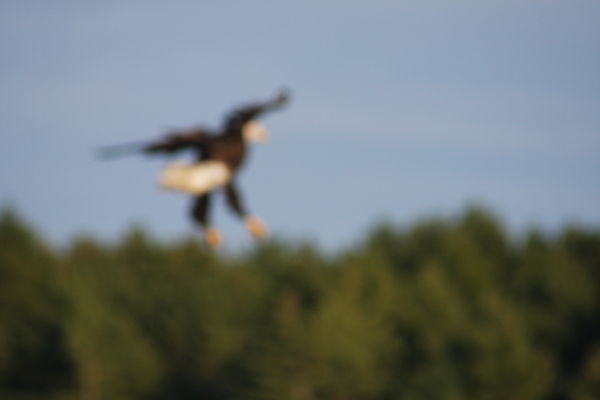Check out Bridge Camera Show Case section of our forum.
Hello from Maine, its getting cold
Sep 28, 2011 20:35:25 #
Hi, I'm the everyday photographer like to have my camera around when a rainbow appears, or if I see my kodac moment of family,sports ,nature. I do not know how to use my camera and settings so i have alot of blurry crap. I'm looking for tips on using my Canon EOS 40D. OK Directions not tips. Tring to get off auto. Wish me luck. My shot tells it all.
The picture i wanted most

Sep 28, 2011 22:35:34 #
Looks like the auto-focus didn't kick in.
In a nutshell, the aperture (f/2.8, f/4, f/5.6, etc.) will determine how much in front of, and behind the subject is in focus (depth of field). Lower numbers = shallower DoF. The shutter speed (1/60, 1/125, 1/250, etc.) are how long the shutter is open (seconds or fractions of a second). The faster speed can capture moving objects without motion blurring. The third part of exposure is the ISO, which is the sensitivity to light - the higher the number, the more sensitive. It's like a bee hive - with more bees (hight ISO), the honey (light) can be processed quicker.
Here are some of exercises for seeing how the settings work. You'll have to look in the user's manual to see how to cjhange the settings.
1. Pick a mid-toned object (green grass, a brick wall) and focus on it. Set the lens to one aperture, and change the shutter speed until you get a centered meter. Write down the aperture and shutter speed, to keep track. Continue through each aperture. This should give you a feel for how the two setting interact.
2. The ISO is the third setting that affects exposure. You can adjust the ISO, leaving aperture and shutter speed alone and see how that affects the meter.
3. Pick one aperture - say f/4. Now take a series of shots ranging the shutter speed from 1/15 or 1/30 second all the way down to 1/250 or 1/500 second. Likewise, pick a speed (1/60 or 1/125 is usually a good one) and shoot through the apertures. I'd stick with "full stops" (2.8, 4, 5.6, 8, 11, 16, 22). Canging the aperture will also allow you see the DoF changes.
Hope it helps.
In a nutshell, the aperture (f/2.8, f/4, f/5.6, etc.) will determine how much in front of, and behind the subject is in focus (depth of field). Lower numbers = shallower DoF. The shutter speed (1/60, 1/125, 1/250, etc.) are how long the shutter is open (seconds or fractions of a second). The faster speed can capture moving objects without motion blurring. The third part of exposure is the ISO, which is the sensitivity to light - the higher the number, the more sensitive. It's like a bee hive - with more bees (hight ISO), the honey (light) can be processed quicker.
Here are some of exercises for seeing how the settings work. You'll have to look in the user's manual to see how to cjhange the settings.
1. Pick a mid-toned object (green grass, a brick wall) and focus on it. Set the lens to one aperture, and change the shutter speed until you get a centered meter. Write down the aperture and shutter speed, to keep track. Continue through each aperture. This should give you a feel for how the two setting interact.
2. The ISO is the third setting that affects exposure. You can adjust the ISO, leaving aperture and shutter speed alone and see how that affects the meter.
3. Pick one aperture - say f/4. Now take a series of shots ranging the shutter speed from 1/15 or 1/30 second all the way down to 1/250 or 1/500 second. Likewise, pick a speed (1/60 or 1/125 is usually a good one) and shoot through the apertures. I'd stick with "full stops" (2.8, 4, 5.6, 8, 11, 16, 22). Canging the aperture will also allow you see the DoF changes.
Hope it helps.
Oct 27, 2011 19:46:55 #
If you want to reply, then register here. Registration is free and your account is created instantly, so you can post right away.
Check out Landscape Photography section of our forum.

